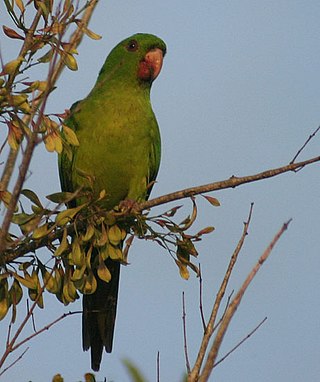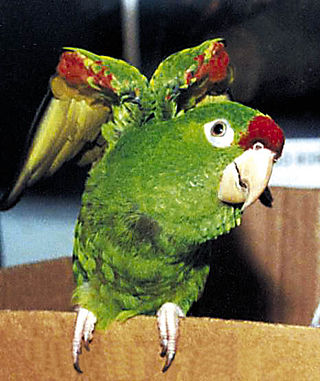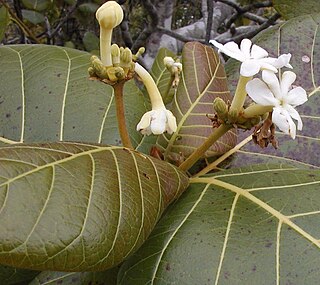
The Revillagigedo Islands or Revillagigedo Archipelago are a group of four volcanic islands in the Pacific Ocean, known for their unique ecosystem. They lie approximately 458 kilometres (285 mi) from Socorro Island south and southwest of Cabo San Lucas, the southern tip of the Baja California Peninsula, and 698 to 1,092 kilometres west of Manzanillo. Historically linked to the Mexican state of Colima, to which they were granted in 1861 to establish a penal colony, the islands are under Mexican federal property and jurisdiction.

Socorro Island is a volcanic island in the Revillagigedo Islands, a Mexican possession lying 600 kilometres (370 mi) off the country's western coast. The size is 16.5 by 11.5 km, with an area of 132 km2 (51 sq mi). It is the largest of the four islands of the Revillagigedo Archipelago. The last eruption was in 1993.

The Socorro dove or Grayson's dove is a dove species which is extinct in the wild. It was endemic to Socorro Island in the Revillagigedo Islands off the west coast of Mexico. The last sighting in its natural habitat was in 1972 and it only survives in captivity. A reintroduction program is being prepared.

The Socorro mockingbird is an endangered mockingbird endemic to Socorro Island in Mexico's Revillagigedo Islands. The specific epithet commemorates the American ornithologist Andrew Jackson Grayson.

The green parakeet, green conure or Mexican green conure is a New World parrot. As defined by the International Ornithological Committee (IOC), it is native to Mexico and southern Texas in the Rio Grande Valley..

The sulphur-winged parakeet, also known as Hoffmann's conure in aviculture, is a species of bird in subfamily Arinae of the family Psittacidae, the African and New World parrots. It is found in Costa Rica and Panama.

The Chatham parakeet, also known as Forbes' parakeet, is a rare parakeet endemic to the Chatham Islands group, New Zealand. This parakeet is one of New Zealand's rarest birds and is classified as Vulnerable on the IUCN Red List, as a result of a range of threats to the species survival, including habitat loss, predation, and hybridization. A number of conservation methods have been employed to assist the recovery of this species, and currently the population trend is considered stable.

The Socorro parakeet, known in aviculture as the Socorro green conure or Socorro conure, is a species of bird in subfamily Arinae of the family Psittacidae, the African and New World parrots. It is endemic to Socorro Island in the Revillagigedo Islands, Mexico.

The Hispaniolan parakeet is a Vulnerable species of bird in subfamily Arinae of the family Psittacidae, the African and New World parrots. It is endemic to the island of Hispaniola which is shared by the Dominican Republic and Haiti. In the former country it is called "perico" and in the latter "perruche".

Finsch's parakeet, also known as the crimson-fronted parakeet and in aviculture as Finsch's conure, is a species of bird in subfamily Arinae of the family Psittacidae, the African and New World parrots. It is found in Costa Rica, Nicaragua, and Panama.

The brown-throated parakeet, also known as the St. Thomas conure or brown-throated conure in aviculture, is a species of bird in the subfamily Arinae of the family Psittacidae, the African and New World parrots. It is found in Costa Rica, Panama, the northern mainland of South America, and islands off the South American coast.
The Espíritu Santo antelope squirrel is a species of antelope squirrel in the family Sciuridae. It is endemic to Mexico, where it is known only from the island of Espíritu Santo in the Gulf of California. The species was originally described by Edward William Nelson and Edward Alphonso Goldman in 1909 as a subspecies of the white-tailed antelope squirrel, a wide-ranging species in the southwestern U.S. and Mexico. In 1938, Arthur H. Howell elevated the subspecies to full species status, on the basis of slightly larger skull proportions and the absence or reduction of the third upper premolar. Studies of DNA and chromosomes have variously suggested close relationships with Harris's antelope squirrels or other subspecies of white-tailed antelope squirrel. A 2007 comparison of DNA and morphological traits suggested the differences between Espíritu Santo squirrels and those on the Baja California peninsula and other islands were not enough to warrant distinct species but rather a subspecies of white-tailed antelope squirrels. Since 2008 the IUCN has similarly recognized the Espíritu Santo antelope squirrel as a subspecies of white-tailed antelope squirrel.

Guettarda is a plant genus in the family Rubiaceae. Most of these plants are known by the common name velvetseed.
Sideroxylon socorrense is a plant species in the family Sapotaceae. It is endemic to Mexico, native to Socorro Island in the Revillagigedo Islands and to the Pacific coast states of Sinaloa and Nayarit on the Mexican mainland.

Guettarda speciosa, with common names sea randa, or zebra wood, is a species of shrub in the family Rubiaceae found in coastal habitats in tropical areas around the Pacific Ocean, including the coastline of central and northern Queensland and Northern Territory in Australia, and Pacific Islands, including Micronesia, French Polynesia and Fiji, Malaysia and Indonesia, Maldives and the east coast of Africa. It reaches 6 m in height, has fragrant white flowers, and large green prominently-veined leaves. It grows in sand above the high tide mark.

Psidium oligospermum, the Galápagos guava or guayabillo, is a small tree or shrub native to the tropical Americas, ranging from Mexico through the Revillagigedo Islands, Central America, Cuba, Puerto Rico, the Windward Islands, the Galápagos Islands, and South America to central Brazil and northwestern Argentina.

Weinmannia pinnata, commonly known as the bastard briziletto, is a species of tree in the family Cunoniaceae. It is native to Mexico, Central America, South America and the West Indies. It typically grows in wet habitats at high elevations, and is one of the species found in dwarf forests perpetually wreathed in clouds.

The Tuamotu tropical moist forests is a tropical and subtropical moist broadleaf forests ecoregion in the Tuamotu Archipelago of French Polynesia and the Pitcairn Islands.
Samuelssonia is a monotypic genus of flowering plants belonging to the family Acanthaceae. It has only one known species, Samuelssonia verrucosa, a small tree which grows to 5 meters tall which is native to the Massif de la Hotte in Haiti.
Ilex socorroensis is a species of flowering plant in the holly genus (Ilex). It is a tree native to Socorro Island in the Revillagigedo Islands west of Mexico's Pacific coast. It is a small tree, growing up to 8 meters tall.















